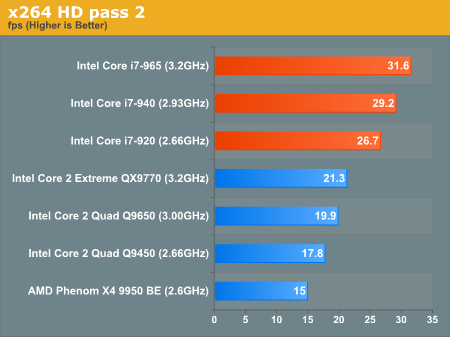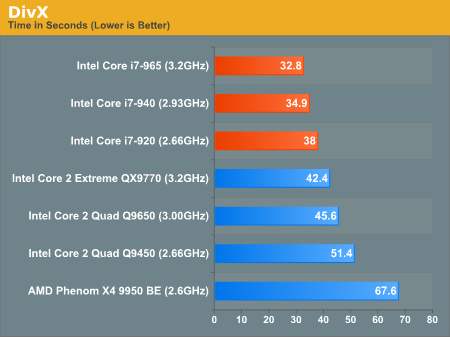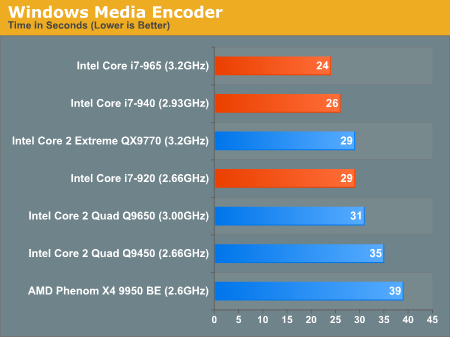The Dark Knight: Intel's Core i7
by Anand Lal Shimpi & Gary Key on November 3, 2008 12:00 AM EST- Posted in
- CPUs
Video and Media Encoding Performance
Nehalem is happiest in 3D rendering applications, but video encoding is a close second place. Our first video encoding test is Tech ARP's x264 HD benchmark, which does a test encode of a 720p source file using the x264 codec. We're reporting results from the 0.59.819 version of x264.

Here Nehalem can "only" deliver a 17% performance advantage over Penryn, but once again the $284 i7-920 is faster than the $1400 QX9770.

Our DivX test is the same DivX / XMpeg 5.03 test we've run for the past couple of years now, the 1080p source file is encoded using the unconstrained DivX profile, quality/performance is set balanced at 5 and enhanced multithreading is enabled:

You know the drill, Intel introduces a new architecture and obsoletes its old one - the i7-920 is looking mighty tempting...
The WME test gives us a little dose of reality, the i7-920 is only as fast as the QX9770 here:

Although this isn't a video encoding test I wanted to include a lighter workload to illustrate a situation where Nehalem is no faster than its predecessor. The iTunes benchmark is a simple WAV to MP3 encode and Nehalem isn't able to dominate here:

Penryn pulls slightly ahead at the top end but at 2.66GHz it falls slightly behind. In both cases the point is that you'll be faster with a QX9770 than an i7-920, and you'll be no faster with a Nehalem vs. Penryn.










73 Comments
View All Comments
Gary Key - Monday, November 3, 2008 - link
"The 920 to 3.6/3.8 is a nice overclock but I wonder what you mean by proper cooling and how close you came to crossing the 80C "boundary"?"It was actually quite easy to do with the retail cooler, in fact in our multi-task test playing back a BD title while encoding a BD title, the core temps hit 98C. Cinebench multi-core test and OCCT both had the core temps hit 100C at various points. Our tests were in a closed case loaded out with a couple of HD4870 cards, two optical drives, three hard drives, and two case fans.
Proper cooling (something we will cover shortly) consisted of the Thermalright Xtreme120, Vigor Monsoon II, and Cooler Master V8 along with the Freezone Elite. We were able to keep temps under 70C with a full load on air and around 45C with the Freezone unit.
Th3Eagle - Tuesday, November 4, 2008 - link
Wow, thats interesting. Can't wait to see the new article. Always nice to see an article about coolers.Thanks for the reply.
Anand Lal Shimpi - Monday, November 3, 2008 - link
Gary did the i7-920 tests so I'll let him chime in there, we're also working on an overclocking guide that should help address some of these concerns.-A
whatthehey - Monday, November 3, 2008 - link
Tom's? You might as well reference HardOCP....Okay, THG sometimes gets things right, but I've seen far too many "expose" articles where they talk about the end of the world to take them seriously. Ever since the i820 chipset fiasco, they seem to think everything is a big deal that needs a whistle blower.
Anandtech got 3.8GHz with an i7-920, and I would assume due diligence in performance testing (i.e. it's not just POSTing, but actually running benchmarks and showing a performance improvement). I'm still running an overclocked Q6600, though, and the 3.6GHz I've hit is really far more than I need most of the time. I should probalby run at 3.0GHz and shave 50-100W from my power use instead. But it's winter now, and with snow outside it's nice to have a little space heater by my feet!
The0ne - Monday, November 3, 2008 - link
TomHardware and Anandtech were the one websites I visited 13 years ago during my college years. Tom's has since been pushed far down the list of "to visit sites" mainly due to their poor articles and their ad littered, poorly designed website. If you have any type of no-script enable there's quite a bit to enable to have the website working. The video commentary is a joke as they're not professionals to get the job done professionally...visually anyhow.Anandtech has stayed true to it's root and although I find some articles a bit confusing I don't mind them at all. Example of this are camera reviews :)
GaryJohnson - Monday, November 3, 2008 - link
Geez, calling a core 2 a space heater. How soon we forget prescott...JarredWalton - Monday, November 3, 2008 - link
I think overclocked Core 2 Quad is still very capable of rating as a space heater. The chips can easily use upwards of 150W when overclocked, which if memory serves is far more than any of the Prescott chips did. After all, we didn't see 1000W PSUs back in the Prescott era, and in fact I had a 350W PSU running a Pentium D 920 at 3.4 GHz without any trouble. :-)Griswold - Tuesday, November 4, 2008 - link
Funny comparison. If it was just for the space heater arguments sake (well, 150W is by far not enough to qualify as a real space heater to be honest), I could follow you but saying the 150W of a 4 core, more-IPC-than-any-P4-can-ever-dream-of, processor should or could be compared to the wattage of the infamous thermonuclear furnace AKA prescott, is a bit of a long stretch, dont you think? :pRyan Smith - Monday, November 3, 2008 - link
Intel can call it supercalifragilisticexpialidocious until they're blue in the face, but take it from a local, it's Neh-Hay-Lem. Just see how it's pronounced in this news segment:http://www.katu.com/outdoors/3902731.html?video=YH...">http://www.katu.com/outdoors/3902731.html?video=YH...
mjrpes3 - Monday, November 3, 2008 - link
Any chance we'll see some database/apache benchmarks based on Nehalem soon?